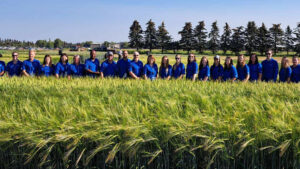
Editor’s Note: This article is part of a series on major contributions to plant breeding and science in Canada’s public sector including innovations in: Canola, Barley, Oat, and Triticale, Wheat, Sunflower, Pulses, Oilseeds, Horticultural Crops, and comments from our editorial board.
Making Oats Tastier
AAFC Ottawa
AAFC’s oat breeding and genomics program in Ottawa is pioneering advancements in oat cuisine, pushing boundaries with improved DNA testing for hexaploid oats, facilitating precise early-stage selection in breeding and faster variety introductions to market. By refining genotyping processes and reducing costs, the team now analyzes up to 10,000 samples annually, selecting lines beneficial to Canadian producers and millers.
Collaborating closely with AAFC oat breeders, they’ve compared genomic and visual selection for yield and quality, resulting in the release of a new cultivar and several others under registration trials across key Canadian regions. They’re applying genomics to select parent oat lines tailored to specific growing conditions, rapidly enhancing traits like freezing tolerance. To aid Canadian breeding companies, they offer training in genomics-assisted breeding.
Globally engaged, they’ve contributed to seminal papers on oat genomes and are developing the first oat haplotype database, enabling wider access to oat genomic information.
Oat cultivars developed by Weikai Yan have become highly regarded and widely adopted in key oat-growing regions like Ontario and Quebec. He’s emerged as a leading authority in plant breeding, solidifying his position as one of the most-cited plant breeders globally.
Making Consumers Happier

Crop Development Centre
At the forefront of Aaron Beattie’s research agenda is the quest to imbue barley and oat crops with traits that enhance drought tolerance and disease resistance. By equipping these crops with the tools to thrive under diverse climatic conditions, Beattie’s work holds the promise of stabilizing yields while simultaneously reducing farmers’ reliance on chemical inputs, thus nurturing environmental sustainability for future generations.
But Beattie’s innovations don’t stop there. He’s spearheading efforts to develop hull-less barley varieties, engineered to meet the growing demand for healthier grain options. With higher fibre content and a lower glycemic index, these varieties cater to consumer preferences and bolster nutrition.

100 Years of Breaking New Ground
AAFC Brandon
The AAFC barley breeding program in Brandon, Man., which marks its centennial this year, has made a name for itself when it comes to doing amazing things in barley. Under the leadership of Ana Badea since 2012, the program has released cultivars across malting, feed, and food barley classes, each with unique trait combinations poised for success. These cultivars promise increased revenue, reduced risk, and enhanced stability for Canadian barley growers, thereby fostering economic growth within the industry.
Recent breeding achievements include pioneering elite lines such as TR20273, boasting resistance to stem rust and early maturity, and HB21147, notable for its purple grain colour and high anthocyanin content with health benefits. The program’s research extends to novel approaches like field testing for waterlogging tolerance and the first genome assembly of a Canadian barley cultivar.
Ongoing projects, such as exploring the endophytic seed barley microbiome for microbiome-assisted breeding, underscore the program’s commitment to developing “climate smart” barley cultivars capable of thriving in future climatic conditions while promoting sustainable farming practices and reducing greenhouse gas emissions.
First-of-its-Kind Agronomy Program
AAFC Lacombe

The GROW Barley agronomy program, announced back in February, is underway to accelerate the uptake of newly registered barley varieties. Recognizing the sluggish adoption rates and subsequent industry losses, the project led by Hiroshi Kubota focuses on providing timely, optimized agronomic information to producers as these varieties hit the market.
Collaborating with key stakeholders such as public breeding programs and seed companies in Western Canada, the project aims to streamline the process by conducting agronomic studies in the three years following registration, effectively addressing adoption barriers. By positioning these new varieties as primary choices within four years of registration, the potential return on investment for barley breeding could surpass $40 for every $1 invested by producers, offering a promising outlook for industry growth and sustainability.

Keeping Triticale Alive
Western Crop Innovations
Headquartered in Lacombe, Alta., Western Crop Innovations (WCI) — formerly known as the Field Crop Development Centre — is at the forefront of developing barley and triticale varieties tailored for feed, forage, and malt barley purposes in Alberta.
WCI stands as the sole program in Canada dedicated to both breeding and releasing new triticale varieties, showing how serious it is when it comes to designing versatile crop solutions. Triticale’s adaptability across various climates and soils, coupled with its potential benefits in pest and pathogen management through crop rotation, makes it an important crop.
WCI’s focus is on producing awnless varieties aimed at enhancing palatability, feed efficiency, and ultimately, improving animal health and performance. With a multidisciplinary team spanning biotechnology, pathology, and quality experts, supported by robust international collaborations, WCI has led the charge in releasing barley varieties with novel traits such as nitrogen use efficiency and non-glycosidic nitrile traits. By employing targeted germplasm and accelerating breeding cycles, WCI expedites the delivery of sustainable varieties, which is important for adapting cereals to rapidly changing environmental pressures.

Editor’s Note: This article is part of a series on major contributions to plant breeding and science in Canada’s public sector including innovations in: Canola, Barley, Oat, and Triticale, Wheat, Sunflower, Pulses, Oilseeds, Horticultural Crops, and comments from our editorial board. Use the buttons below to explore these exciting new innovations or read from the start.













